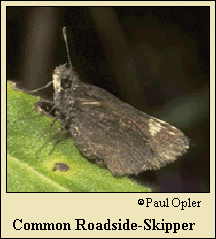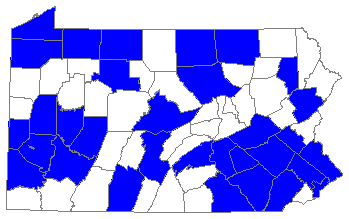 |
 

 |



Common Roadside-Skipper (Amblyscirtes vialis [W. H. Edwards])
Wing span: 7/8 - 1 1/4 inches (2.2 - 3.2 cm).
Identification: Upperside is black with a few small white spots at the tip of the forewing. Underside is dark brown with violet-gray at the forewing tip and the outer half of the hindwing.
Life history: To await receptive females, males perch on the ground or low plants in forest openings or edges, waving their antennae in small circles. Females deposit eggs singly on the host plants; caterpillars eat leaves, and make shelters of rolled and tied leaves. Caterpillars hibernate.
Flight: One brood from March-July; a partial second brood up to September in the south.
Caterpillar hosts: Various grasses including wild oats (Avena), bent grass (Agrostis), bluegrass (Poa), Bermuda grass (Cynodon dactylon), and Indian woodoats grass (Chasmanthium latifolia).
Adult food: These skippers prefer nectar from low-growing blue flowers including verbena and selfheal.
Habitat: Open areas in or near woodland, often close to streams.
Range: The Roadside Skipper is the most widespread skipper in North America. It occurs from British Columbia east across southern Canada to Maine and Nova Scotia; south to central California, northern New Mexico, Texas, the Gulf states, and northern Florida.
Conservation: Not usually required.
The Nature Conservancy Global Rank: G5 - Demonstrably secure globally, though it may be quite rare in parts of its range, especially at the periphery.
Management needs: None reported.
References:
Opler, P. A. and G. O. Krizek. 1984. Butterflies east of the Great Plains. Johns
Hopkins University Press, Baltimore. 294 pages, 54 color plates.
Opler, P. A. and V. Malikul. 1992. A field guide to eastern butterflies. Peterson
field guide #4. Houghton-Mifflin Co., Boston. 396 pages, 48 color plates.
Scott, J. A. 1986. The butterflies of North America. Stanford University Press,
Stanford, Calif. 583 pages, 64 color plates.
Stanford, R. E. and P. A. Opler. 1993. Atlas of western USA butterflies including
adjacent parts of Canada and Mexico. Denver and Fort Collins, CO.
Tilden, J. W. 1986. A field guide to western butterflies. Houghton-Mifflin Co.,
Boston, Mass. 370 pages, 23 color plates.
Author: Jane M. Struttmann
State and Regional References:
Glassberg, J. 1993. Butterflies Through Binoculars: A Field Guide to
Butterflies in the Boston-New York-Washington Region. Oxford Univ. Press,
New York, N.Y. 160 pp.
Layberry, R.A., Hall, P.W. & Lafontaine, D.J., 1998. The Butterflies of
Canada. University of Toronto Press, Toronto, ON. 280 pp.
Opler, P.A. 1998. A field guide to eastern butterflies, revised format.
Houghton Mifflin Co., Boston.
Shapiro, A.M. 1966. Butterflies of the Delaware Valley. American Entomological
Society Special Publication. Philadelphia, PA. 79 pp.
Tietz, H.M. 1952. The Lepidoptera of Pennsylvania. The Pennsylvania State
College School of Agriculture Agricultural Experiment Station. State
College, PA. 194 pp.
Wright, D.M. 1995, Atlas of Pennsylvania Butterflies. Special Private
Publication, Lansdale, PA. 22 pp.

